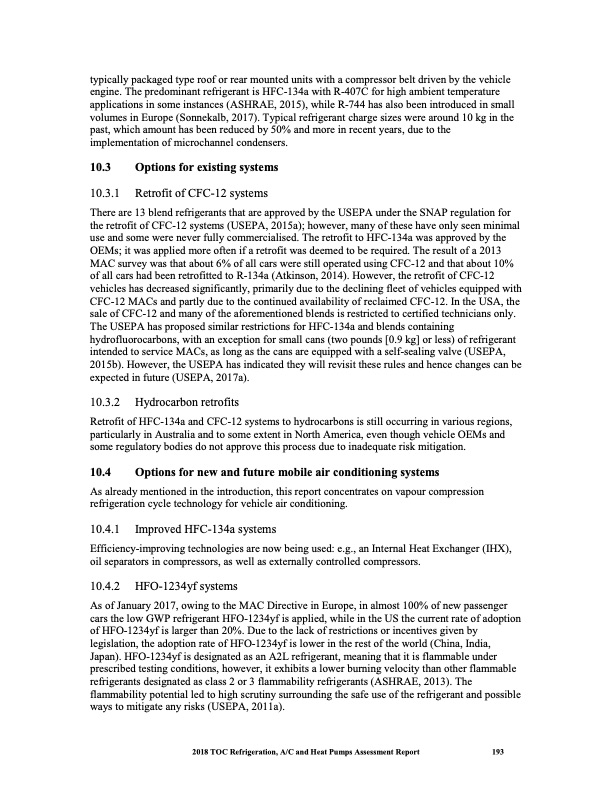
PDF Publication Title:
Text from PDF Page: 206
typically packaged type roof or rear mounted units with a compressor belt driven by the vehicle engine. The predominant refrigerant is HFC-134a with R-407C for high ambient temperature applications in some instances (ASHRAE, 2015), while R-744 has also been introduced in small volumes in Europe (Sonnekalb, 2017). Typical refrigerant charge sizes were around 10 kg in the past, which amount has been reduced by 50% and more in recent years, due to the implementation of microchannel condensers. 10.3 Options for existing systems 10.3.1 Retrofit of CFC-12 systems There are 13 blend refrigerants that are approved by the USEPA under the SNAP regulation for the retrofit of CFC-12 systems (USEPA, 2015a); however, many of these have only seen minimal use and some were never fully commercialised. The retrofit to HFC-134a was approved by the OEMs; it was applied more often if a retrofit was deemed to be required. The result of a 2013 MAC survey was that about 6% of all cars were still operated using CFC-12 and that about 10% of all cars had been retrofitted to R-134a (Atkinson, 2014). However, the retrofit of CFC-12 vehicles has decreased significantly, primarily due to the declining fleet of vehicles equipped with CFC-12 MACs and partly due to the continued availability of reclaimed CFC-12. In the USA, the sale of CFC-12 and many of the aforementioned blends is restricted to certified technicians only. The USEPA has proposed similar restrictions for HFC-134a and blends containing hydrofluorocarbons, with an exception for small cans (two pounds [0.9 kg] or less) of refrigerant intended to service MACs, as long as the cans are equipped with a self-sealing valve (USEPA, 2015b). However, the USEPA has indicated they will revisit these rules and hence changes can be expected in future (USEPA, 2017a). 10.3.2 Hydrocarbon retrofits Retrofit of HFC-134a and CFC-12 systems to hydrocarbons is still occurring in various regions, particularly in Australia and to some extent in North America, even though vehicle OEMs and some regulatory bodies do not approve this process due to inadequate risk mitigation. 10.4 Options for new and future mobile air conditioning systems As already mentioned in the introduction, this report concentrates on vapour compression refrigeration cycle technology for vehicle air conditioning. 10.4.1 Improved HFC-134a systems Efficiency-improving technologies are now being used: e.g., an Internal Heat Exchanger (IHX), oil separators in compressors, as well as externally controlled compressors. 10.4.2 HFO-1234yf systems As of January 2017, owing to the MAC Directive in Europe, in almost 100% of new passenger cars the low GWP refrigerant HFO-1234yf is applied, while in the US the current rate of adoption of HFO-1234yf is larger than 20%. Due to the lack of restrictions or incentives given by legislation, the adoption rate of HFO-1234yf is lower in the rest of the world (China, India, Japan). HFO-1234yf is designated as an A2L refrigerant, meaning that it is flammable under prescribed testing conditions, however, it exhibits a lower burning velocity than other flammable refrigerants designated as class 2 or 3 flammability refrigerants (ASHRAE, 2013). The flammability potential led to high scrutiny surrounding the safe use of the refrigerant and possible ways to mitigate any risks (USEPA, 2011a). 2018 TOC Refrigeration, A/C and Heat Pumps Assessment Report 193PDF Image | Heat Pumps Technical Options

PDF Search Title:
Heat Pumps Technical OptionsOriginal File Name Searched:
RTOC-assessment-report-2018_0.pdfDIY PDF Search: Google It | Yahoo | Bing
CO2 Organic Rankine Cycle Experimenter Platform The supercritical CO2 phase change system is both a heat pump and organic rankine cycle which can be used for those purposes and as a supercritical extractor for advanced subcritical and supercritical extraction technology. Uses include producing nanoparticles, precious metal CO2 extraction, lithium battery recycling, and other applications... More Info
Heat Pumps CO2 ORC Heat Pump System Platform More Info
| CONTACT TEL: 608-238-6001 Email: greg@infinityturbine.com | RSS | AMP |